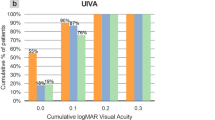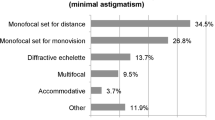Abstract
In a prospective survey, 121 patients received sub-Tenon's block and were interviewed on the same day after their phacoemulsification cataract surgery regarding their visual experience in the operated eye during surgery. Majority of patients (81%) reported that they could see some light during surgery and various colours were seen by 56%. Movements of various descriptions were also reported by 40% of patients. The majority of patients (93%) found the visual experience acceptable but 4% thought it to be unpleasant and 3% found it frightening. Patients undergoing phacoemulsification surgery under sub-Tenon's block experience a variety of visual sensations and some patients may be frightened. All patients should receive appropriate preoperative warning.
Similar content being viewed by others
Introduction
Visual experiences vary during cataract surgery under retrobulbar and peribulbar blocks. 1,2,3 Sensation may be impaired due to injection and spread of the local anaesthetic agent into the close proximity of the optic nerve. Recently introduced sub-Tenon's block is gaining popularity as a safer alternative. The injection is made into sub-Tenon's space to obtain anaesthesia. The anaesthetic agent reaches the proximity of the optic nerve giving a characteristic T-sign seen after B-scan ultrasound.4 It is, therefore, possible that visual sensation may be affected. We are not aware of any survey or study of the effects of sub-Tenon's block on visual experience. We, therefore, conducted a survey of subjective visual experience in patients who had phacoemulsification cataract surgery with intraocular lens implantation under sub-Tenon's block.
Methods and results
After Local Ethical Committee approval, 121 patients who gave informed consent, undergoing routine phacoemulsification cataract surgery with intraocular lens implantation under sub-Tenon's block were included in a prospective post-operative survey. All blocks were performed by trained ophthalmic anaesthetists. The block procedure included topical anaesthesia with two drops of 4% amethocaine, dissection 5–6 mm away from the limbus in the inferonasal quadrant, 4–5 ml of 2% lidocaine hydrochloride with epinephrine (1:200 000) and 30 units/ml of hyaluronidase administered through a 1 in long metal sub-Tenon's cannula. None of the patients had received any perioperative medications that would impair their cognitive function. In the immediate post-operative period, patients were interviewed by nursing staff using a standard questionnaire. The questionnaire explored specific aspects of their visual experience during surgery: seeing any light, variation in light intensity, seeing any coloured images, any moving images, surgeon's fingers, any instruments and the overall impression of their visual experience.
Nineteen per cent (23/121) of patients did not see any light at all during surgery. The remaining 81% (98/121) saw some light. Forty-nine per cent of them thought that there was no change in the intensity of the light during the procedure while 39% said it fluctuated, 8% reported the light becoming brighter and 4% reported the light becoming dimmer towards the end of surgery. Of the patients who could see light, colours were seen by 56% (55/98). The colours included: multicolour 46%, two colours 11%, blue 20%, red 11%, orange 7% and yellow 5%. Forty per cent of patients (39/98) saw some movement which they described as eclipses, circles and shadows in various shapes. On direct questioning, 10% (10/98) of patients agreed that they saw the surgeon's fingers and 7% (7/98) saw instruments during the surgery. The majority of patients (93%) found the visual experience acceptable, 4% thought it to be unpleasant and 3% found it frightening. The results of the survey are shown in Table 1 with other published results for comparison.
Comment
Regional anaesthesia does not always block optic nerve function completely. This has been shown by visual evoked potential (VEP) studies by Ropo et al,5 who found nearly normal VEP in all 12 cases with peribulbar block and extinguished VEP only in three out of seven cases with retrobulbar block.
As local anaesthetic is seen in close proximity to the nerve after sub-Tenon's block,4 some physiological impairment of the optic nerve is possible and it is also possible that some patients may be able to see through the operated eye during surgery due to lack of infiltration of local anaesthetic to the optic nerve. Impairment of visual function after retrobulbar,2 peribulbar3 and topical anaesthesia6,7 are known to occur (Table 1). Although it is difficult to explain how patients under topical anaesthesia can suffer impairment of visual function, perhaps visual perception might be affected by the powerful operating microscope light. This may be a confounding factor in all studies of visual perception after local anaesthesia.
The results of our survey show that visual impairment after sub-Tenon's block can also occur and are comparable to retrobulbar and peribulbar blocks. Furthermore, 7% of patients receiving retrobulbar block2 and up to 15% patients under topical anaesthesia7 are known to report the experience as frightening. Our study found 3% of patients responding to their visual experiences with fright. Sub-Tenon's block, therefore, gives a more favourable response in this respect than retrobulbar block or topical anaesthesia according to these studies.
Interestingly, The Royal College of Ophthalmologists of London ‘Guidelines for Cataract Surgery’ published in 20018 states that patients given local anaesthesia during cataract surgery, ‘you will not be able to see what is happening, but you will be aware of a bright light’. Our study and other studies referred to in this article suggest that the issue is more complicated and perhaps this should be reflected in the guidelines.
Preoperative counselling is known to benefit patients,9 therefore, based on the results of our survey, we recommend that all patients should be given appropriate warning of the possibilities of a wide range of impaired visual sensation during phacoemulsification cataract surgery under sub-Tenon's block. It would be of great value if patients at risk of being frightened could be identified in the pre-assessment clinic but this would require further studies involving a large number of patients.
References
Au Eong KG, Lim TH, Lee ATH, Voon LW, Yong VSH . Subjective visual experience during extracapsular cataract extraction and intraocular lens implantation under retrobulbar anaesthesia. Eye 1999; 13: 325–328.
Au Eong KG, Lim TH, Lee HM, Yong VS . Subjective visual experience during phacoemulsification and intraocular lens implantation using retrobulbar anesthesia. J Cataract Refract Surg 2000; 26: 842–846.
Murdoch IE, Sze P . Visual experience during cataract surgery. Eye 1994; 8: 666–667.
Winder S, Atta HR . Ultrasonic localization of anesthetic fluid in sub-Tenon's, peribulbar, and retrobulbar techniques. J Cataract Refract Surg 1999; 25: 56–59.
Ropo A, Ruusuvaara P, Setala K . Visual evoked potentials after retrobulbar or periocular anaesthesia. Br J Ophthalmol 1992; 76: 541–544.
Newman DK . Visual experience during phacoemulsification cataract surgery under topical anaesthesia. Br J Ophthalmol 2000; 84: 13–15.
Au Eong KG, Low CH, Heng WJ, Aung T, Lim TH, Ho SH, Yong VS . Subjective visual experience during phacoemulsification and intraocular lens implantation under topical anaesthesia. Ophthalmology 2000; 107: 248–250.
The Royal College of Ophthalmologists. Cataract Surgery Guidelines. The Royal College of Ophthalmologists: London, 2001.
Voon LW, Au Eong KG, Saw SM, Verma D, Laude A . Does preoperative counselling reduce the fear of patients from visual experience during phacoemulsification under topical anaesthesia?—Preliminary results of a multicentre randomised clinical trial. Presented at the First Singapore Eye Research Institute International Meeting, Singapore, 27–30 September 2001.
Acknowledgements
The abstract of this survey was presented at the Annual National Meeting of the British Ophthalmic Anaesthesia Society, August 2001, Middlesbrough, UK. The authors are grateful to the ophthalmic day unit and anaesthetic staff for helping in data collection.
Author information
Authors and Affiliations
Corresponding author
Rights and permissions
About this article
Cite this article
Prasad, N., Kumar, C., Patil, B. et al. Subjective visual experience during phacoemulsification cataract surgery under sub-Tenon's block. Eye 17, 407–409 (2003). https://doi.org/10.1038/sj.eye.6700370
Published:
Issue Date:
DOI: https://doi.org/10.1038/sj.eye.6700370
Keywords
This article is cited by
-
Evaluating the accuracy of a cataract surgery simulation video in depicting patient experiences under conscious anesthesia
International Ophthalmology (2023)
-
Correlation between sub-Tenon’s anesthesia and transient amaurosis during ophthalmic surgery
International Ophthalmology (2020)
-
Incidence and impact factors of intraoperative loss of light perception under sub-Tenon’s anesthesia in patients with macular diseases
Eye (2019)
-
Video recording and light intensity change analysis during cataract surgery using an animal model
Graefe's Archive for Clinical and Experimental Ophthalmology (2019)
-
Which colours are seen by the patient during cataract surgery? Results of an intraoperative interview
Eye (2016)



